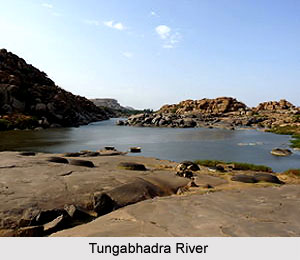 Tungabhadra River is formed by the confluence of two rivers, the Tunga River and the Bhadra River. Both these rivers flow down the eastern slope of the Western Ghats in Karnataka. Along with Nethravathi, the Tunga and the Bhadra rise at Gangamoola, in Varaha Parvatha in the Western Ghats. Bhadra River flows through the Industrial City Bhadravathi. About one hundred tributaries, streams, creeks, rivulets and the like contribute to each of these two rivers. Both these rivers join at Kudali, at an elevation of about 610 metres near Holehonnur, about 15 km from Shimoga.
Tungabhadra River is formed by the confluence of two rivers, the Tunga River and the Bhadra River. Both these rivers flow down the eastern slope of the Western Ghats in Karnataka. Along with Nethravathi, the Tunga and the Bhadra rise at Gangamoola, in Varaha Parvatha in the Western Ghats. Bhadra River flows through the Industrial City Bhadravathi. About one hundred tributaries, streams, creeks, rivulets and the like contribute to each of these two rivers. Both these rivers join at Kudali, at an elevation of about 610 metres near Holehonnur, about 15 km from Shimoga.
Tungabhadra meanders through the plains and mingles with river Krishna at Gondimalla, near the famous Alampur in Mahaboobnagar District of Andhra Pradesh. Varada is the main tributary of Tungabhadra.
There are many holy places all along the rivers which include temples of Shaiva Cult on the banks of River Bhadra and Tunga. Sringeri, Sarada Petham was established by Adi Shankaracaharya. There is also a cluster of Nava Brahma temples that have been constructed by the early Chalukyas. There are flood protection walls all along the rivers that were constructed by Sri Krishna Devaraya between 1525 and 1527 AD.
Thereafter the river takes a north-easterly direction through rugged ridges formed by boulders piled on ancient granite outcroppings. The river has cut through weaker rocky substrata of the Hampi landscape. It has created a narrow gorge where granite hills shut in the river in a deep ravine. The river then flows east, joining the Krishna River in Andhra Pradesh.
This article is a stub. You may enrich it by adding more information to it. You can send your write-up at content@indianetzone.com















